Furthering art thro’ saleability
By Dilshan BOANGE
‘Art for art’s sake’ is a romantic ideal that disregards the
‘marketability’ of the work, possibly to the extent that ‘price tagging’
is denounced as ungainly and to be frowned upon. But how far has that
taken the artist in surviving in this present day system is a question
that lies at the heart of the message conveyed through the artistic
endeavour unveiled by Charith Senadheera on August 25 and 26 when his
book of Sinhala ‘poetry’ FOR SALE was launched followed by the opening
of his exhibition of visual art that also bore the same title.
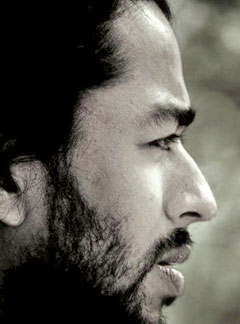 The endeavour by Charith merits discussion with focus on his
conceptualisation of the book, which in my opinion cannot be simply
labelled a book of poetry since the contents are of a nature whose very
unconventionality states defiance of genre classifications, as well as
the ideas of this creative expressionist whose concept of ‘Visual
poetry’ was intended to be spotlighted in the exhibition. The endeavour by Charith merits discussion with focus on his
conceptualisation of the book, which in my opinion cannot be simply
labelled a book of poetry since the contents are of a nature whose very
unconventionality states defiance of genre classifications, as well as
the ideas of this creative expressionist whose concept of ‘Visual
poetry’ was intended to be spotlighted in the exhibition.
FOR SALE is Charith’s first artistic project done on a public scale
but his talents have reached audiences, although perhaps understated.
A product of Ananda College, Colombo he was the lyricist who wrote
the song Ananthayata yana para dige which became a popular hit among
young music lovers and became quite veritably the launching pad for
vocalists such as Kasun Kalhara and Indrachapa Liyanage. Charith is now
a designer at MAS having graduated with a degree in fashion designing
from the Moratuwa University and had been working on the publication FOR
SALE for nearly five years.
Initial impressions
One of my initial impressions about the exhibition on learning about
Charith’s professional and educational background was whether the
visuals were based on perhaps some designs he did while in university or
had some link or basis to what he would create for his place of
employment. The simple answer was a polite ‘No’.
“When graduates from any field of aesthetic studies go to work what
happens is they find their artistic passions can’t be pursued any
longer. Their artistic essence, their skills their knowledge, go into
serving the industry.” Thus the FOR SALE project was in certain ways
Charith’s way of breaking out of that matrix into which creative young
people become enmeshed. Perhaps it was a benign rebellion of sorts in a
way to show that a person with creative passions to create works of art
must not let their sparks for passionate expression become dulled along
the path to succeed professionally.
A point that becomes rather contentious perhaps when discussing on
the lines of what art should be in its purpose to serve the artist and
also society is how Charith views and projected as the central idea of
his project, that ‘saleability’ of art matters, and matters
significantly for the survival of both the artist and his art. He
positions this argument very specifically looking at the present state
of how Sinhala medium literature especially ‘poetry’ stands in a market
context to insufficiently remunerate the artist and the parties that
undertake to finance an artistic project.
Suffering
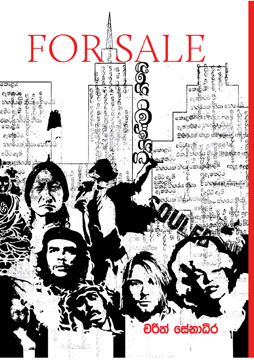 “An artist needn’t necessarily be a sufferer. And his life shouldn’t
be a tragedy. But people tend to think the inheritance of an artist is
suffering and poverty. “An artist needn’t necessarily be a sufferer. And his life shouldn’t
be a tragedy. But people tend to think the inheritance of an artist is
suffering and poverty.
That shouldn’t be so. He should be financially stable and have the
means to continue his work as an artist, by earning through his art.
Sadly that isn’t possible here in our country.” The project FOR SALE was
in that sense a spark of rebelliousness in trying to bring in objectives
of ‘market reach’ and give the ‘shape’ of a Sinhala medium book of verse
a newer positioning.
The ‘social politics’ of the venue have in this regard played a
significant role to help Charith in his objectives. The place was a
warehouse of the Park Street Mews set up where an upper market segment
of society can be reached.
It had created an opportunity to open the artistic endeavour of an
essentially Sinhala medium expressionist to audiences that included
foreigners who although may not be literate in Sinhala would possibly
appreciate the calligraphic elements that are centrally at play in his
art. The fact that some events of the Colombo International Music
Festival coincided with FOR SALE at the same premises had also worked to
Charith’s advantage.
Dividends
“Park Street Mews has a certain upmarket culture” Charith noted “For
a Sinhala medium practitioner having your work unveiled at a place like
this helps reach a stratum that generally wouldn’t make an effort to go
looking for events like the launch of a Sinhala poetry book held in some
of the more familiar places where the crowd is essentially the usual
faces. Having it in a place like this helped create that cross-section
which I really hoped for. To me it’s about creating the opportunity for
a larger audience to see my work and hopefully appreciate it.”
Before going to a more detailed discussion about the book and its
elements a focus on the one of the key ingredients and approaches to
characterise Charith’s work must be better grasped. One of the
conceptual underpinnings of the art form that he presented through FOR
SALE the exhibition is that the nature of his use of Sinhala is not to
be thought of as serving literature or art in a traditional sense.
Language as calligraphy
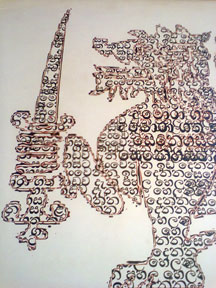 Language seen as words which can be deconstructed to alphabetical
characters can be seen as evincing, when looking at the manner in which
they have been employed, how Charith perceives words for their
calligraphic quality. Perhaps the artist also viewed them as having
aesthetic facets in terms of their curvature and appearance. It is
likely that such a quality is what is meant to reach out to attract a
person who cannot read Sinhala. But that does not mean the words don’t
construct meanings. Far from it; the ‘politics’ that are painted onto
the art are only too obvious when one takes a look at some of the pieces
that have themes of gender politics to nationalism inscribed
unapologetically. Language seen as words which can be deconstructed to alphabetical
characters can be seen as evincing, when looking at the manner in which
they have been employed, how Charith perceives words for their
calligraphic quality. Perhaps the artist also viewed them as having
aesthetic facets in terms of their curvature and appearance. It is
likely that such a quality is what is meant to reach out to attract a
person who cannot read Sinhala. But that does not mean the words don’t
construct meanings. Far from it; the ‘politics’ that are painted onto
the art are only too obvious when one takes a look at some of the pieces
that have themes of gender politics to nationalism inscribed
unapologetically.
One such piece is the one that has overlapping sentences that
translate as ‘sword brandishing’ ‘putting down’ and so on, forming the
image of the lion of our national flag. These pieces take the form of
what Charith classified as ‘Visual poetry’ which by his explication is
not a widely practised form of expression here although there have been
notable figures who had used it as a method.
In my own critical viewing which would take on an approach of looking
at the work for its resonance or conformation to what its classification
literally would translate or communicate, I feel the term ‘Visual
poetry’ must be ‘stretched’ in order to encompass Charith’s pieces,
since the words that form sentential meanings blending with images and
at times forming images and becoming patterns by itself do not fulfil an
element of poetry by virtue of the words alone.
William Blake was known to have fused verse with his paintings and
one may allude to such sources to find perhaps a more fuller sense of
the concept that seems to be the grounding for the term ‘Visual poetry’.
However, my own observations cannot make any declarations of absolutism
but merely provide food for thought.
Writing as readable images
“Seeing a picture with Sinhala words forming an image may be seen in
one way by a Sinhala reader and in a totally different way by a
foreigner when it is hung enlarged like any other picture on a wall.”
Arguably a facet of thinking working in the mind of Charith is his ideas
conceived as words taking the form of a modern Sinhala calligraphy.
He feels to ones who cannot read Sinhala the visual appeal in the
manner it has been assembled and patterned may spur curiosity to find
out what it means literally. That could in certain ways have a whole
other set of politics at work where perceptions are affected about a
visually appreciated piece to one that is then seen as ‘readable
material’. “I see many young people who have Chinese, Japanese words
tattooed on their arms and shoulders and such. Can they really read
those characters? When you ask them they tell you its meaning. That’s
something to think about. The visual attraction it has creates a
curiosity for us to learn what it means as ‘writing’.”
There is much truth in his argument that warrants contemplation on
what words and characters of a language we cannot read is worth to us?
Perhaps their ‘appearance’ their ‘form’ serves a purpose of
ornamentation.
The book FOR SALE
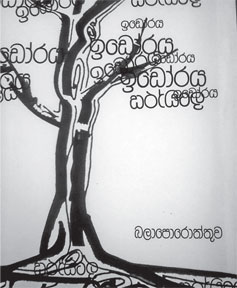 FOR SALE, the exhibition was also the launching pad of FOR SALE the
book which is something of a potpourri along the lines of Charith’s
conception of ‘Visual poetry’ as well as illustrations by his wife
Kithmini to enhance and complement the book’s visual qualities that come
by way of the verses that are arranged in figurative formations. As a
book, FOR SALE is rather problematic to simply label a book of poetry
since the idea of genre is not very well adhered to by the artist cum
poet. FOR SALE, the exhibition was also the launching pad of FOR SALE the
book which is something of a potpourri along the lines of Charith’s
conception of ‘Visual poetry’ as well as illustrations by his wife
Kithmini to enhance and complement the book’s visual qualities that come
by way of the verses that are arranged in figurative formations. As a
book, FOR SALE is rather problematic to simply label a book of poetry
since the idea of genre is not very well adhered to by the artist cum
poet.
“There are no more strict borders, as I feel, between genres of art.”
Said Charith whose idea of a genre defying endeavour is better depicted
through the book, than the exhibition of ‘visuals’. The foreword to the
book is by K. K Saman Kumara a name renowned in the spheres of
contemporary Sinhala writing. The principal review of the book at the
launch had been by him and a speech had also been made by Prof. Sarath
Wijesuriya the Sinhala don from Colombo varsity. And Charith said his
expectations of gaining a space for a wider cross-section of society was
achieved through having the book launch at his chosen venue.
“If people from the strata that frequent Park Street Mews come to
appreciate my poetry, I’m sure it may strengthen Sinhala writers who
generally don’t attempt to reach an audience like the people who you
would find in this kind of environment.”
When Charith expresses thus one is impelled to query how much of his
Sinhala poetry would be found ‘accessible’ from a point of language to
persons who may not be able to read Sinhala, the prime example being
foreigners who are regular patrons of the venue. Perhaps the exhibition
FOR SALE is the main focus for that segment whilst urban upper class
readers who would not generally mark on their schedule diary a Sinhala
poetry book launch would be the irregular additions to a hopeful
readership.
But the book as said of it earlier is not the general book of poetry
that one comes across. The poetry is entirely of the free verse form yet
its assortment of content renders it something of a book of drawings or
sketches as well. To Charith a book is not the inner contents on the
pages alone. “A book is the whole product. It’s not just the words. That
is why I made the jacket of the book the way it is. The design is
intended to be appealing and persuade a person to pick it up and turn
the pages inside.”
What lies inside?
And what lies in the pages held between the cover? The assortment is
as said before remarkably diverse. The free styled verses are easy going
and flow in a balance of expressions which capture a sense of the
literary and colloquy. There are sketches that are line drawings. And of
course a host of ‘Visual poetry’. The verses are of themes that range
from love and heartache to sensuality to war to solitary contemplations.
On page 30 is a single liner which would translate to English as –‘If I
only I could see myself through your eyes.’ Certainly in the more
classical and traditional sense such a composition may not count as a
fully developed ‘poem’ but the more modern contemporary expressionism
that is entering the Sinhala cannon would now provide room for free
flowing prosaic verse to be considered as poetry in the true sense of
the word. Another such single liner is on page 39 which translates to
English as ‘Mirror, at least now show me my own face.’ Touching on the
theme of voyeurism the poem on page 50 translates to English as
–‘Through the key hole of the locked door, paradise...?’
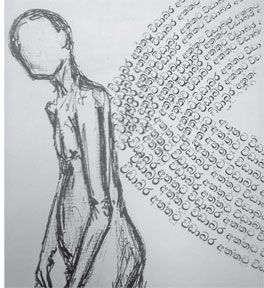 ‘Visual poetry’ in FOR SALE is to be found in several types. One is
where words have been made part of sketched line drawings as what is
found on page 82 which shows something of a fatigued male figure
dragging his feet with wings shaped by rows of words that make up that
translate as –‘Weary wings’. And then on page 48 which is red in colour
is a swastika made of the Sinhala word for ‘Democracy’ in black print. ‘Visual poetry’ in FOR SALE is to be found in several types. One is
where words have been made part of sketched line drawings as what is
found on page 82 which shows something of a fatigued male figure
dragging his feet with wings shaped by rows of words that make up that
translate as –‘Weary wings’. And then on page 48 which is red in colour
is a swastika made of the Sinhala word for ‘Democracy’ in black print.
Ideological directions?
What is Charith’s approach meant to serve from a point of ideological
framework? The somewhat not very pleasant question was posed taking into
consideration how his outlooks and intentions conveyed through his
project spoke of the need to reach for markets, and at that the
inclusivity of the upper social strata. “That is a good question” was
what Charith began his response with when asked if his views expressed
through FOR SALE are of a ‘free market’ oriented rightwing politics. “I
don’t think today there is much of a difference between left and right
politics since its much of the same people who have been crossing from
one camp to the other, and back again. As I see it there is no
difference.”
Inference of lines being blurred between the leftism and the
rightwing in our present day context may be one way for Charith to
position a pragmatism to his project’s projected ideas rather than
giving it a ‘camp specific’ purpose. But surely there is a sense of
calling upon the artist to become more receptive to the opportunities of
a market oriented system, and thereby reap its benefits.
FOR SALE is a project of creativity that was of two components that
have at its core a message that Art being made as ‘saleable’ is not
vulgarism. Charith’s creativity through FOR SALE has been put up for
sale in two forms, as exhibits and as a book.
How ‘Visual poetry’ in the form of ornamentations or art pieces will
work to capture a market and how books of the nature of Charith’s
publication will capture readers to be a financially viable enterprise
can be seen only with the passage of time and the entry of more creative
artists of the likes of Charith who will offer more art intended for
sale.
There is no doubt that FOR SALE stands on a platform of innovative
thinking and conceptualisation and by understanding how creative
expressions can touch the pulse of audiences and the markets they form,
perhaps these novelties can become highly valued and prized in an ever
modernising world with its expanding opportunities.
|


